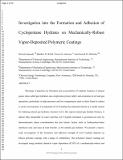Investigation into the Formation and Adhesion of Cyclopentane Hydrates on Mechanically Robust Vapor-Deposited Polymeric Coatings
Author(s)
Gleason, Karen K.; Sojoudi, Hossein; Gleason, Karen K; McKinley, Gareth H
DownloadInvestigation into the formation.pdf (935.2Kb)
PUBLISHER_POLICY
Publisher Policy
Article is made available in accordance with the publisher's policy and may be subject to US copyright law. Please refer to the publisher's site for terms of use.
Terms of use
Metadata
Show full item recordAbstract
Blockage of pipelines by formation and accumulation of clathrate hydrates of natural gases (also called gas hydrates) can compromise project safety and economics in oil and gas operations, particularly at high pressures and low temperatures such as those found in subsea or arctic environments. Cyclopentane (CyC5) hydrate has attracted interest as a model system for studying natural gas hydrates, because CyC5, like typical natural gas hydrate formers, is almost fully immiscible in water; and thus CyC5 hydrate formation is governed not only by thermodynamic phase considerations but also kinetic factors such as the hydrocarbon/water interfacial area, as well as mass and heat transfer constraints, as for natural gas hydrates. We present a macroscale investigation of the formation and adhesion strength of CyC5 hydrate deposits on bilayer polymer coatings with a range of wettabilities. The polymeric bilayer coatings are developed using initiated chemical vapor deposition (iCVD) of a mechanically robust and densely cross-linked polymeric base layer (polydivinylbenzene or pDVB) that is capped with a covalently attached thin hydrate-phobic fluorine-rich top layer (poly(perfluorodecyl acrylate) or pPFDA). The CyC5 hydrates are formed from CyC5-in-water emulsions, and differential scanning calorimetry (DSC) is used to confirm the thermal dissociation properties of the solid hydrate deposits. We also investigate the adhesion of the CyC5 hydrate deposits on bare and bilayer polymer-coated silicon and steel substrates. Goniometric measurements with drops of CyC5-in-water emulsions on the coated steel substrates exhibit advancing contact angles of 148.3 ± 4.5° and receding contact angles of 142.5 ± 9.8°, indicating the strongly emulsion-repelling nature of the iCVD coatings. The adhesion strength of the CyC5 hydrate deposits is reduced from 220 ± 45 kPa on rough steel substrates to 20 ± 17 kPa on the polymer-coated steel substrates. The measured strength of CyC5 hydrate adhesion is found to correlate very well with the work of adhesion between the emulsion droplets used to form the CyC5 hydrate and the underlying substrates.
Date issued
2015-04Department
Massachusetts Institute of Technology. Department of Chemical Engineering; Massachusetts Institute of Technology. Department of Mechanical EngineeringJournal
Langmuir
Publisher
American Chemical Society (ACS)
Citation
Sojoudi, Hossein; Walsh, Matthew R.; Gleason, Karen K. and McKinley, Gareth H. “Investigation into the Formation and Adhesion of Cyclopentane Hydrates on Mechanically Robust Vapor-Deposited Polymeric Coatings.” Langmuir 31, no. 22 (June 2015): 6186–6196 © 2015 American Chemical Society
Version: Author's final manuscript
ISSN
0743-7463
1520-5827